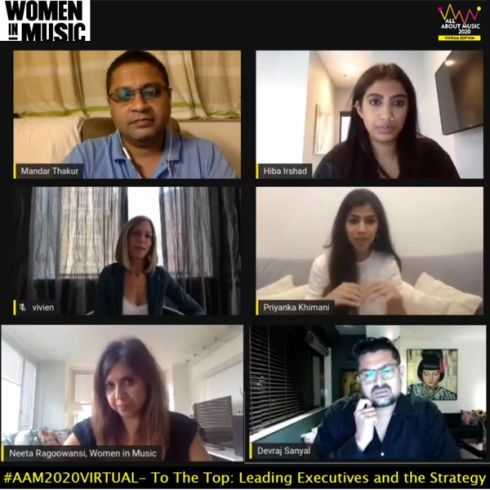
MUMBAI: The fourth edition of All About Music conference, held virtually from August 18-20, was a one of its kind event for the Indian music scene. From hosting interviews of legendary musicians to discussing key business issues in a post-Covid world, it touched upon many important topics.
Quite naturally, most sessions revolved around the changing landscape of the music industry because of the pandemic. The entire live event scene does not function any more and that has reduced revenues massively. Panels were also held on how musicians can cope with the changing scenario.
Day 1
Music has shifted from live shows to screens. That was the topic for the panel ‘All About The Business Post Covid’. Pointing out the importance of social media today, Vijay Subramaniam said, “Digital business is booming. New commerce models are coming up. Influencers are more demanded than celebrities.”
Another important session was the candid chat between composer Shankar Mahadevan and Uttar Pradesh folk singer Malini Awasthi. They discussed the undeniable impact of folk on Indian mainstream music and how it found its way into old Bollywood songs. “Folk songs are not just for entertainment factor but talk about the culture and lives of people,” said Awasthi. Intrigued, Mahadevan wondered whether any archiving has been done as folk is a treasure chest.
In the panel ‘Pitch Your Song to Labels’, the quality of songs played this year was above a certain mark. Some songs were professionally produced while others were simple home-made recordings. Especially the song ‘Swag Swargam’ by Kushal Mangal was loved by all, prompting Satvinder Singh Kohli to want to work with the artiste.
Last but not the least, the craft of songwriting was dissected by celebrated American songwriter Savan Kotecha in his masterclass. He advised that for a song to be a hit, melody needs to be good. “A great melody is a great melody no matter what! At first, I used to do lyrics. But later when I learnt about phonetics, I realized that a great lyric supports the melody, not the other way round,” he said.
Day 2
The recent uproar over lyricists not getting due credit was touched upon in the Prasoon Joshi’s interactive session with Raj Nayak. “I am appalled by some platforms which have not given credit to lyricists. They need to be fair,” said Joshi.
In another celebrity chat session, superstar Yo Yo Honey Singh urged upcoming musicians to do something unique. “Don’t let go of your stubbornness and determination to do what you want to do. Money and exposure may come or not but you have to stick to what you want to do,” he said.
But fame is something that doesn’t come easy to all, especially indie musicians who are always overshadowed by the gigantic film industry. In the session ‘All About Growing Indie’, journalist Amit Gurbaxani pointed out that indie artistes have been affected the most due to pandemic because their major earnings are dependent on live performances.
Since earnings have shifted to streaming platforms now, it could be easier if artistes worked with music labels. Singer Aabha Hanjura shared her experience, “Signing with a label makes things easier but a lot of activities still falls on the artiste. Labels can push songs and make it easier for the artiste who can focus on making music.”
Day 3
When talking about a minority in the industry, one cannot forget folk musicians. Abhinav Agarwal, founder of Anahad Foundation, said “70% of India’s music industry is made up of folk artistes, but only 2% of the revenues go to this 70%. They do not have a digital presence nor resources for recording their music.”
This subject was further broached upon by Assamese folk musician Kalpana Patowary in the session ‘Back to the Roots’. Ghazal singer Pankaj Udhas pointed out the need for radio to give attention to non-film music. “For such forms of music to prosper, more coverage is needed on television and radio. Especially radio – it only plays film music!” he said. Another vital entity for such musical forms is the preservation of language. This was pointed out by Roopkumar Rathod.
But all said and done, regional music is the next big thing in India. Its phenomenal growth, especially in Punjab was pointed out by Siddhartha Roy in his keynote speech ‘Regional Music is the new Mainstream’.
In the session ‘Pitch your songs to Filmmakers’, the existence of a perfect song was completely squashed. However, panelists agreed that for songs to be noticed, they shouldn’t be generic. “Composers need to do something which is different enough that will make me come to them, something which is not available in the industry,” said Luv Ranjan.
This idea is best understood when one looks at the work of Oscar-winning composer A.R. Rahman. In his conversation with singer Arijit Singh, Rahman revealed that he had to stretch every corner of the score to come up with something new because more or less everything was already done by giants in the South Indian music industry.
They also discussed how to incorporate less explored Indian classical music into mainstream scores to make it sound more Indian and not the Western musical trend it follows today.
Inarguably, the most interesting sessions of the conference were the pitching of songs to filmmakers and record labels. It was also established that though non-film music is on the rise, regional commercial music is far up the ladder than artistic indie music. Artistes need to up their game to get noticed by the audience as well as stakeholders in the industry, where streaming statistics are becoming more important than putting up good shows.